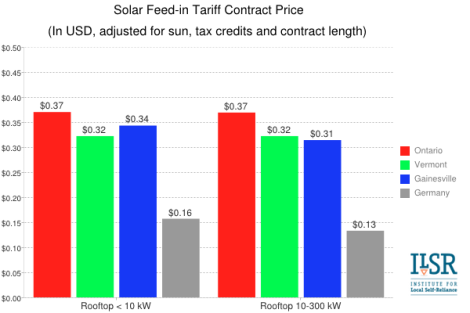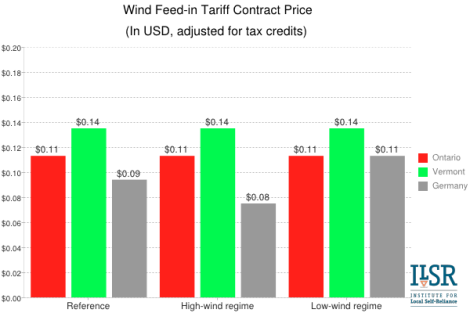A version of this post originally appeared on Energy Self-Reliant States, a resource of the Institute for Local Self-Reliance.
Ontario just completed a revision of their landmark feed-in tariff program and rates for renewable electricity generation and prices fell sharply: 30 percent for solar and 15 percent for wind power. This continues a trend of falling costs for renewable energy around the world.
As a bit of background, Ontario’s feed-in tariff gives wind and solar producers (and many other technologies) long-term contracts at premium prices to support deployment of new renewable energy. In a unique marriage of environmental and economic goals, the province also provides price bonuses to community-based projects and requires wind and solar projects to source much of their labor and materials within Ontario (for more on this, see our 2011 report).
Modeled after Germany’s landmark program, Ontario is starting to see the price declines as their renewable energy market matures. Here’s a quick look at how the new prices stack up against world-leader Germany, as well as against two of the prominent feed-in tariff programs in the United States, Vermont and Gainesville. The prices for all programs have been changed to U.S. dollars, adjusted to the same contract length of 20 years, and to an equivalent solar insolation (for Gainesville, Fla.). Prices for U.S. programs were also increased by 30 percent to account for the federal tax credit, which is usually taken in addition to the feed-in tariff contract price. More on the methodology can be found in this post.

For solar, Ontario pays a rate comparable to other North American jurisdictions, but all of them pay much more than Germany. Germany pays half of what North American feed-in tariff programs do for the same size solar project.
For wind power, Ontario pays less than Vermont (which caps wind projects at just 1.5 megawatts), but still more than Germany’s mature wind market. Unlike its North American counterparts, Germany’s tariff adjusts based on the quality of the wind regime. In the reference scenario (~6 meter per second wind at a height of 50 meters), Germany’s price paid is a full 2 cents per kWh less than American producers. In a high wind scenario (7 meter per second wind), Germany pays even less. Only in a low-wind regime does Germany’s tariff price compare to Ontario.

Ultimately, the test of success for Ontario’s clean energy program is its outcomes and public support. Despite public outcry about high prices paid to renewable energy producers, the prospect for over 43,000 jobs and nearly 5,000 megawatts of clean energy sustained feed-in tariff supporters in the recent government election and the program will continue.


